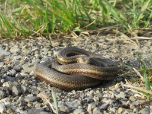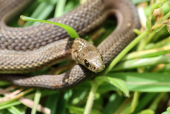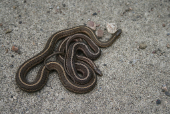Short-Headed Garter Snake (Thamnophis brachystoma)
Description: T. brachystoma is a small species of snake, with a total length (including tail) of 10.0 to 22.0 inches. There is no apparent distinction between the body and head. Unlike Thamnophis sirtalis, there are no black spots between stripes in T. brachystoma. Dorsal coloration tends to be olive or olive-green with three (1 dorsal, 2 lateral) beige to yellow stripes running the length of the body. There is a distinct sexual dimorphism in this species with females being larger than males.
Habitat: The shorthead garter snake is commonly found in old fields and meadows, but can occasionally be found in wooded areas. It is almost always found within several hundred meters of a field. It is believed that on sunny days it will be openly basking; however, when a population study was conducted, it was almost invariably found under objects such as wood and rocks. Individuals were only encountered in the open on cloudy days.
Range: T. brachystoma is found in small pockets in northwestern Pennsylvania and southwestern New York. Outside of its natural range, there is an introduced population in Pittsburgh in southwestern Pennsylvania.
Found in these States:
NY |
PA
Diet: In the wild, T. brachystoma feeds exclusively on earthworms. However, in captivity shorthead garter snakes may consume other food items such as leeches, salamanders, frogs, and fish.
Reproduction: Reproduction in T. brachystoma occurs in spring shortly after emerging from the hibernacula. Females generally emerge with ovarian follicles already well developed. Females in New York breed every other year while females in Pennsylvania breed annually. Males use stored sperm for breeding. The testes are small after emergence, reaching full size by midsummer. After this point, sperm will be stored for later use in the spring. T. brachystoma is believed to be viviparous, with experiments showing a transfer of amino acids between mother and offspring.
Status: Listed as Least Concern since, although its extent of occurrence is probably not much more than 20,000 km, it is common and reasonably adaptable with a presumed large population, and it is unlikely to be declining fast enough to qualify for listing in a more threatened category.
»» Kingdom: Animalia - Animals
»» Phylum: Chordata - Chordates
»» Subphylum: Vertebrata - Vertebrates
»» Class: Reptilia - Reptiles
»» Order: Squamata - Scaled Reptiles
»» Suborder: Serpentes
»» Superfamily: Colubroidea
»» Family: Colubridae - Colubrids
»» Genus: Thamnophis
»» Species: Thamnophis brachystoma - Short-Headed Garter Snake
This article uses material from the Wikipedia article "Shorthead garter snake", which is released under the Creative Commons Attribution-Share-Alike License 3.0. Content may have been omitted from the original, but no content has been changed or extended.
|













